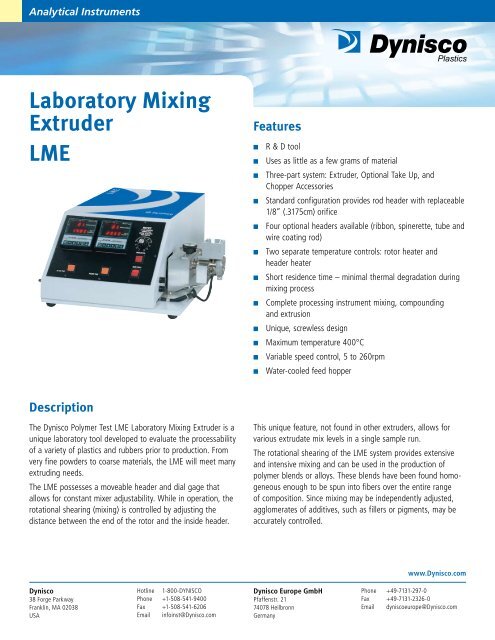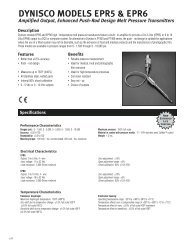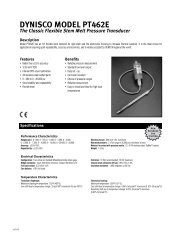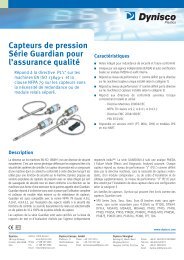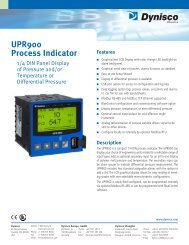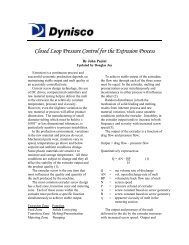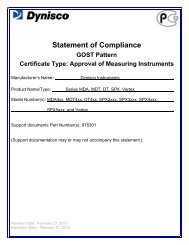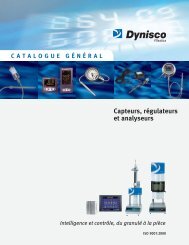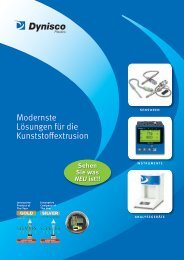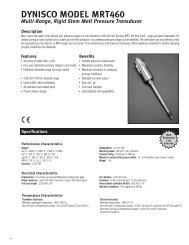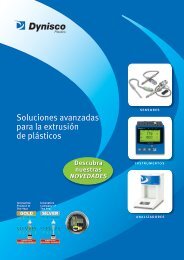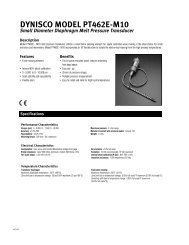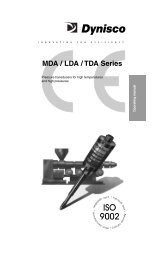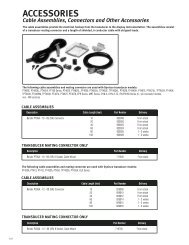Laboratory Mixing Extruder LME - Dynisco Instruments
Laboratory Mixing Extruder LME - Dynisco Instruments
Laboratory Mixing Extruder LME - Dynisco Instruments
You also want an ePaper? Increase the reach of your titles
YUMPU automatically turns print PDFs into web optimized ePapers that Google loves.
Analytical <strong>Instruments</strong><br />
<strong>Laboratory</strong> <strong>Mixing</strong><br />
<strong>Extruder</strong><br />
<strong>LME</strong><br />
Features<br />
n R & D tool<br />
n Uses as little as a few grams of material<br />
n Three-part system: <strong>Extruder</strong>, Optional Take Up, and<br />
Chopper Accessories<br />
n Standard configuration provides rod header with replaceable<br />
1/8” (.3175cm) orifice<br />
n Four optional headers available (ribbon, spinerette, tube and<br />
wire coating rod)<br />
n Two separate temperature controls: rotor heater and<br />
header heater<br />
n Short residence time – minimal thermal degradation during<br />
mixing process<br />
n Complete processing instrument mixing, compounding<br />
and extrusion<br />
n Unique, screwless design<br />
n Maximum temperature 400°C<br />
n Variable speed control, 5 to 260rpm<br />
n Water-cooled feed hopper<br />
Description<br />
The <strong>Dynisco</strong> Polymer Test <strong>LME</strong> <strong>Laboratory</strong> <strong>Mixing</strong> <strong>Extruder</strong> is a<br />
unique laboratory tool developed to evaluate the processability<br />
of a variety of plastics and rubbers prior to production. From<br />
very fine powders to coarse materials, the <strong>LME</strong> will meet many<br />
extruding needs.<br />
The <strong>LME</strong> possesses a moveable header and dial gage that<br />
allows for constant mixer adjustability. While in operation, the<br />
rotational shearing (mixing) is controlled by adjusting the<br />
distance between the end of the rotor and the inside header.<br />
This unique feature, not found in other extruders, allows for<br />
various extrudate mix levels in a single sample run.<br />
The rotational shearing of the <strong>LME</strong> system provides extensive<br />
and intensive mixing and can be used in the production of<br />
polymer blends or alloys. These blends have been found homogeneous<br />
enough to be spun into fibers over the entire range<br />
of composition. Since mixing may be independently adjusted,<br />
agglomerates of additives, such as fillers or pigments, may be<br />
accurately controlled.<br />
www.<strong>Dynisco</strong>.com<br />
<strong>Dynisco</strong><br />
38 Forge Parkway<br />
Franklin, MA 02038<br />
USA<br />
Hotline 1-800-DYNISCO<br />
Phone +1-508-541-9400<br />
Fax +1-508-541-6206<br />
Email infoinst@<strong>Dynisco</strong>.com<br />
<strong>Dynisco</strong> Europe gmbH<br />
Pfaffenstr. 21<br />
74078 Heilbronn<br />
Germany<br />
Phone +49-7131-297-0<br />
Fax +49-7131-2326-0<br />
Email dyniscoeurope@<strong>Dynisco</strong>.com
Analytical <strong>Instruments</strong><br />
Procedure<br />
A sample material is placed in a cooled hopper where it falls onto the heated<br />
surface of a cylindrical rotor. As the rotor turns, the material drags against the<br />
inclined surface of the stationary scroll. This motion begins transport toward<br />
the outlet die. As the material collects in the radial gap it is compressed by<br />
the converging space between the scroll surface and end of the header case.<br />
The material then moves to the axial gap where it is rotationally sheared<br />
between the end of the rotor and inside of the case. This motion induces a<br />
centripetal pumping effect, enabling the material to flow to the outlet die<br />
and exit through the orifice.<br />
Optional Features<br />
<strong>LME</strong> Take Up System<br />
The Take Up System is a multi-purpose variable drive machine. It can draw and<br />
wind very small diameter extrudate fibers from the <strong>LME</strong> onto a spindle or draw<br />
larger rods through a pair of nip rollers. The nip rollers can also be used with<br />
the optional ribbon header. In all cases, the speed of the system can be adjusted<br />
to match the rate of extrusion and provide the desired fiber/rod diameter or<br />
tape/ribbon width. The nip rollers are also used to guide the extrudate rod to<br />
the Chopper (pelletizer) system.<br />
<strong>LME</strong> ChopPer<br />
The Chopper pelletizes the extrudate from the Take Up System. Extrudate feeds<br />
into the chopper inlet from the nip roller of the Take Up System. The size of the<br />
pellets is determined by the feed speed to the chopper.<br />
Uses and Applications<br />
n Plastics and rubbers<br />
n Pelletizing<br />
n Shape extrusions<br />
n Polymer blends<br />
n Film extrusions<br />
n Fiber spinning<br />
n Wire coating<br />
n Melt spinning<br />
Compounding Of:<br />
n Stabilizers<br />
n Fillers<br />
n Plasticizers<br />
n Flame retardants<br />
n Pigments<br />
n Antioxidants<br />
n Pharmaceuticals<br />
n A d d i t i v e s<br />
Specifications<br />
Dimensions<br />
Standard Header<br />
Included<br />
19”W x 24”D x 9”H (49cm x 61cm x 23cm)<br />
1/8” (0.312cm) diam. orifice (replaceable);<br />
rod extrusion<br />
Weight<br />
Cooling Water Feed<br />
Hopper<br />
Electrical<br />
120 lbs. (54.5kg)<br />
1 gal/hr tap water (3.785L/hr)<br />
230V, 50Hz/120V, 50Hz/120V, 60Hz<br />
All dimensions are in inches (millimeters).<br />
©2011. <strong>Dynisco</strong> reserves the right to make changes without notice.<br />
Refer to www.dynisco.com for access to Operator Manual and other support documentation.<br />
DDS2760069 DS010411 <strong>Laboratory</strong> <strong>Mixing</strong> <strong>Extruder</strong> 2


